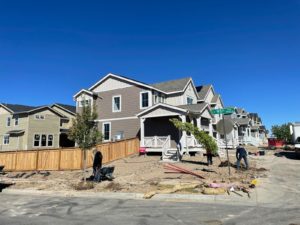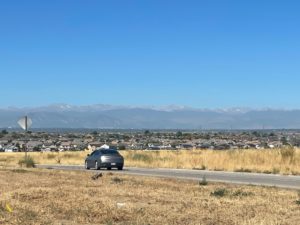BRIGHTON — Adams 27J Superintendent Chris Fiedler jokes that he gets heartburn just driving around the school district he has overseen for the past 10 years.
The pace at which 27J is growing has caused the school district to ask voters nine times in the past 20 years (with three of those asks, including this year’s, under Fiedler) for more than $1 billion in new funding to build schools to house an ever-growing student population.
A big ask for rapid growth

Around $375 million of that has thus far been successful, but this November more than half of that billion-plus will come in one large ask to voters — $515 million in bond debt, as well as a mill levy override to raise $16 million more annually in property tax revenue for the district’s ongoing operations.
“It used to be when you drove down Tower (Road) you couldn’t see those homes,” Fiedler said. “Because there was a ridge, now they are all up against Tower, and it’s just nuts. It’s really nuts.”
The more than 214 square mile school district, that encompasses three counties and three municipalities, is home to 23 district-managed schools, six charter schools and 20,000 pre-kindergarten through 12th grade students. All of its schools sit inside Adams County.
The district is also home to one of the fastest growing cities in the state — Commerce City.
The north metro-area community and its 67,000 residents is just 20 minutes from downtown Denver, 20 minutes from Denver International Airport and offers a quick link to just about all of the metro area with E-470, which runs right through the middle.
“We’re the last available space in this northeast corner of the Denver Metro Area,” Fiedler said. “It’s all that’s left. There is land available. And, comparatively, we have affordable housing. Homes are always a little less on this side of (US Hwy) 85.”

All things combined, Commerce City has become attractive to young couples looking to start their families. Those young families, however, have caused 27J to grow at such a rapid speed, Fiedler said, that he’s watched his district grow by 1,200 new students from last year to this year alone.
“We’ve got all of them out here just building away,” Fiedler said about the half-dozen or so contractors putting up master-planned developments at every open corner. “It gives me heart palpitations. I mean, seriously, we have to serve them.”
Fiedler said while some districts can build schools for kids that are coming. Adams 27J needs schools for kids that are already there, and even the bond request going to voters in November, is only a bandage.
“This will handle maybe the next 6-8 years, and then we’ll be out again for another bond,” Fiedler said.
In fact, in addition to the current half-billion dollar ask, since 1996, 27J has asked voters for nine bonds. Four have failed. Five have passed. Since 2006, voters have authorized $337 million in bonds. If passed, the 2021 bond package would pay for two new elementary schools, two new middle schools, one comprehensive high school, add STEM (science, technology, engineering and math) and technical centers to all the existing high schools, safety and security upgrades and technology upgrades. Additionally, a portion of the money will go to all 27J’s six public charter schools.
Charter-friendly district
When the last bond for $248 million passed in 2015, Fielder said they asked him then how long it would last. His response was: “In six years, we better be thinking about it. In eight years, we better have it, and in 10 years, if we don’t, we’re going to have a problem.”

He was off by a year. It’s been five years, and the district is full again, splitting at the seams, says Fiedler. So much so that he was named Charter School Authorizer of the year last year because he keeps allowing new charter schools into the district to stave off some of the expense of new schools to taxpayers.
That is still true, the district recently approved another charter — Willow Bend Academy — that erased $33 million from the bond ask. And another, Classical Academy has filed the paperwork to expand its operation into 27J.
“Otherwise, we would have had to ask for $550 million,” Fiedler said. “And we are likely to approve the new one too.”
If all applications are approved, that would make 27J one of the most charter friendly districts in the state per capita, with one charter school for every 2,500 students it serves. In fact, several years ago, the district was recruiting charters to its boundaries and encouraging students to attend them to free up seats in the district.
If the bond doesn’t pass, it may get back to that point again.
“I’ve always been charter friendly,” Fiedler said. “We have to have a place for kids to go.”
Fielder was not new to the Northern Colorado area when he began his career in Adams 27J in 2005 as a principal at the then Thimmig K-8 School in Henderson. The 1986 Greeley West High School graduate left Thimmig to become principal at Prairie View High School in 2009 and was named Superintendent in 2012.
When asked how long this bond would last, Fiedler adjusted his numbers slightly, although there appears to be no relief in sight, he admitted.
“I’d for sure subtract a year, if not two years, from that projection,” Fiedler said. “We should be thinking about (asking for another bond) in four-five years, probably going to need it in five-six, and if were not successful in six to seven, we’re going to be in trouble.”
Fiedler said he understands the concerns of those life-long residents who feel like the district is always coming to them for money, but there just isn’t any other options, he said, when families are moving in as fast as they can build, which from April to October this year alone has resulted in hundreds of homes in the Reunion master-planned community in Commerce City.

“These were all basements in April,” Fiedler pointed out as he drove Complete Colorado around on a tour of the district late last month. “This is just Commerce City, there is also east and west Brighton and Thornton that are growing rapidly.”
And they all have large amounts of open space for continued growth.
“We are going to partner with these families for a long time,” Fiedler said. “This is the next generation.”
Public/private partnership
The district and the municipalities it encompasses have come up with some reprieve, but still not enough to shoulder all the cost.
The Capitol Facility Fee Foundation was created as a public/private partnership among municipalities, developers, and builders. It’s a voluntary collection of $865 per single family unit and $494 per multi-family unit from those developers to expand or construct new schools.
Since its inception in 2001, it has collected more than $15 million that has helped 27J with capital expenses. Additionally, the municipalities have a cash-in-lieu program that requires new developments to either set aside donated land to hold a new school for the growth or give the school district an equal amount of cash to purchase land elsewhere.
The mayor of Commerce City said that is still not enough.
“We have a long way to go when it comes to how we fund the construction of schools,” Mayor Benjamin Huseman said. “While I’m grateful we have a code out there that says that land has to be dedicated in order to make sure schools are built, we have to also make sure that we are providing adequate funding to ensure that those schools can be constructed. We need more schools in commerce city. We have unprecedented growth. We have more than tripled in size in the last 20 years.”
Commerce City will hit 70,000 residents in the next few months, Huseman said.

“That is just crazy,” Huseman said. “We are doing year-over-year an increase of about 3,000 residents per year. There are communities out there that won’t do that in a decade. So the need for schools is tremendous, and that’s why its critically important that the bond passes to allow us to continue on the path to providing a quality education for our students.”
Huseman said that legislators need to find a way to change the model in which schools are funded.
“It is not enough to just dedicate a piece of land and put the onerous on taxpayers to go out there and fund the construction,” he said. “It’s important the funding of that construction lies where it should, the people that are profiting off the growth of this community.”
It doesn’t end with just the construction of the schools, however, Fiedler said.
Money for staffing
The district is also asking for a mill-levy increase of 8 mills that would generate, at minimum, $16 million a year in additional revenue to help staff the schools. The district has not had an increase to its mill levy for general fund purposes in more than two decades. The last was 21 years ago when the voters agreed to a flat $750,000 a year in extra revenue. As the value of homes has increased, the amount of that mill has gone down. It currently sits at .33 of one mill.
Fiedler said as the assessed value of the district goes up, so does the local share of the state’s School Finance Act — a complicated formula that determines how much money per pupil a district receives from the state. The formula is based on local assessments, so despite property taxes increasing, the district does not receive the extra money. The increase only decreases the state’s responsibility.
The mill levy override is different. Any revenue generated from that stays in the district.
“The challenge for us is anytime there is a cut to the School Finance Act, we take it on the chin because we don’t have any other source of revenue,” Fiedler said.
All of the other Adams County school districts have mill levy overrides that generate millions in additional revenue, so as assessed values continue to rise, so does their funding. As it stands, the $750,000 the district does receive amounts to about $38 per student. The additional mill levy override — if it passes — will increase that to about $800 per student.
Even then, says Fiedler, 27J will still be far behind.
“We have got to get on board,” Fiedler said. “The 8 mills will move us from last to last.”
Fiedler’s comment may sound odd, but at $38 per student, 27J is in last place in the Denver area for per pupil funding. At $800 of local funding per student, it will remain in last place.
He said selling a mill levy override to voters is much harder than selling a bond.

“We don’t do ribbon cuttings for new curriculum. We don’t do ribbon cuttings for launching (new programs). We don’t roll out the red carpet when we hire new staff,” he said. “More than anything when people agree to support a bond, they see what they’ve invested in, can drive by and see the walls, and take a tour. On the mill levy override side people don’t think they know where the money goes.”
The mill levy would cost homeowners 15 cents per-day on every $100,000 in value per home, or $219 per year on a $400,000 home.
Fiedler said the district has been able to raise its graduation rate to 86.2 percent. Only five districts in the Denver-Metro areas have higher rates, Douglas County, Boulder Valley, Littleton, Cherry Creek, and St. Vrain, all districts with much higher per-pupil revenue.
Fiedler, along with 27J Board of Education President Greg Piotraschke, hope voters see how fiscally responsible the district has been with their money in the 10 years Fiedler’s been at the helm and give them some breathing room for the next few years.
“We have used money wisely,” Piotraschke said. “One of the things that we do that other districts haven’t is we have a bond oversight committee that is made up of two board members plus two people from our southern, our western, and our Brighton core area that are making suggestions and giving public oversight to make sure the money is being spent wisely.”
For 27J, the money will go a long way, Fiedler said, as the district is already facing shortages in teachers, support staff and bus drivers. To combat that, the district moved to a four-day week a few years ago. The only topics left to bring back to the table if it fails are split schedules and year-round school.
“We are operating on 80 percent of the revenue of our neighbors,” Fiedler said. “And we’re in the people business. So, it means we’re paying our people 80 percent of what everyone else around us is paying. At some point, a 20 percent pay cut isn’t worth the day off, so they will go work somewhere else.”


